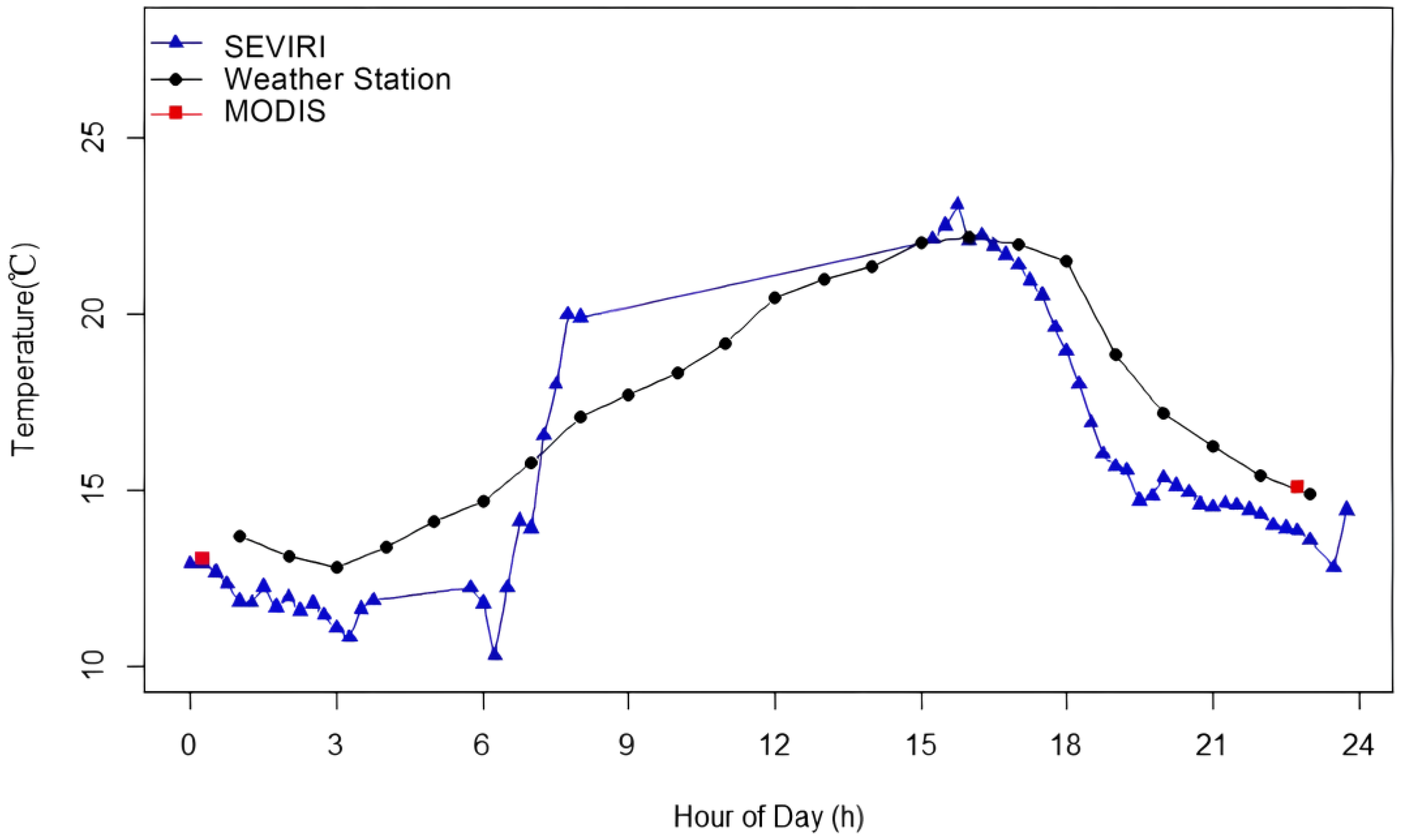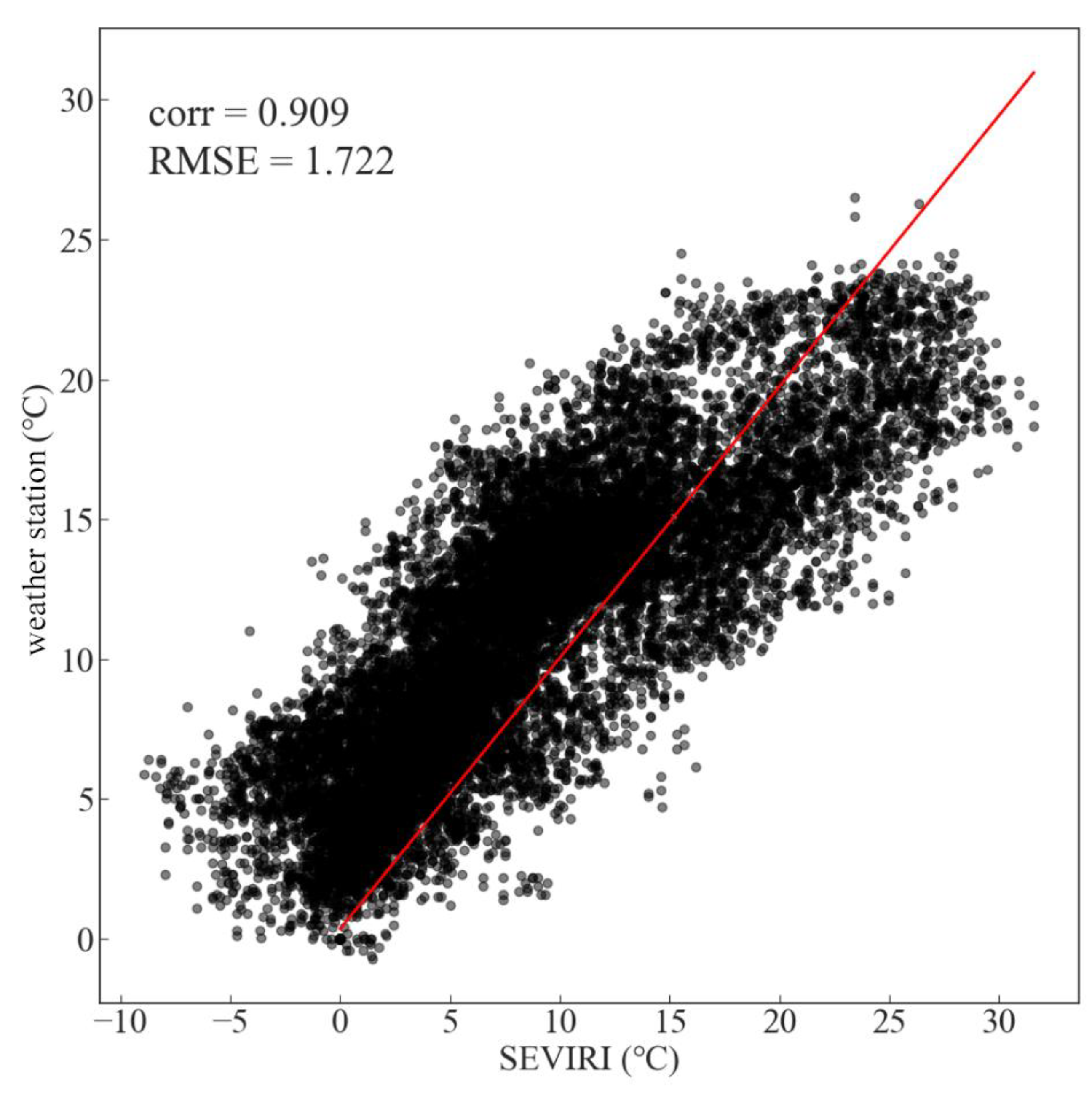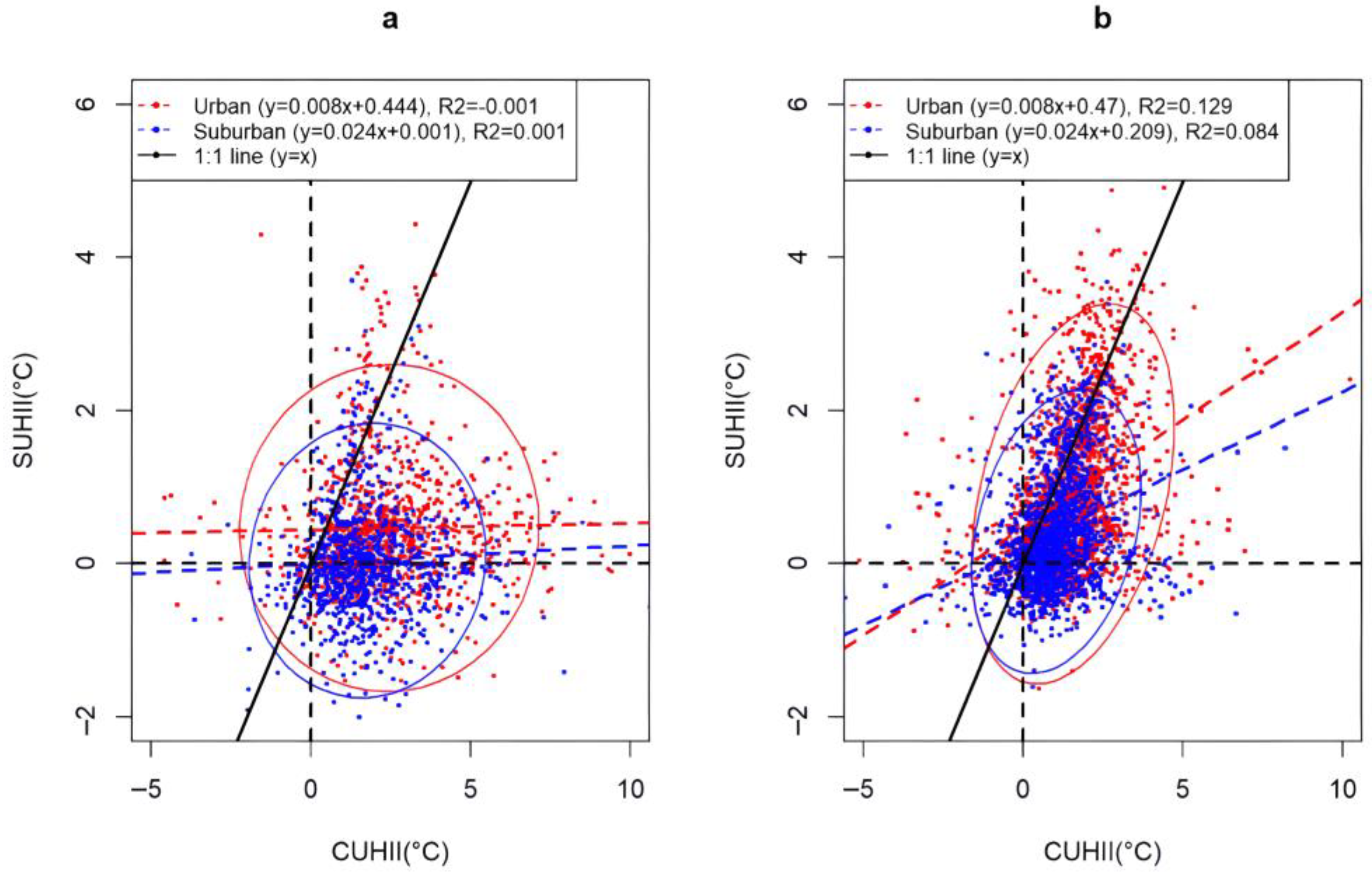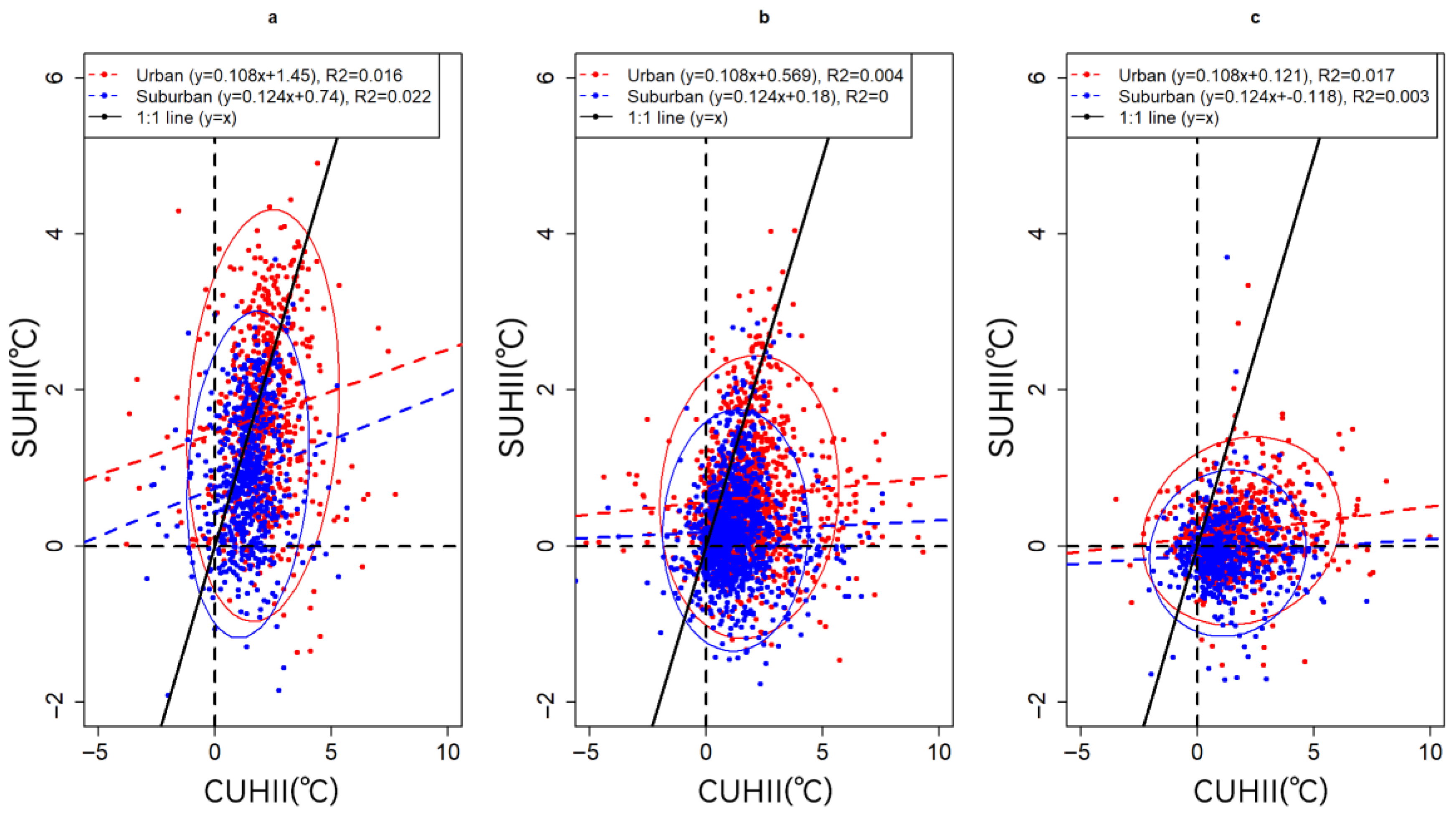Diurnal Variation in Urban Heat Island Intensity in Birmingham: The Relationship between Nocturnal Surface and Canopy Heat Islands
Abstract
:1. Introduction
2. Materials and Methods
2.1. Study Area
2.2. Meteorological Data
2.3. Site Classification
2.4. Satellite Data
2.4.1. SEVIRI Satellite
2.4.2. Temporal and Spatial Consistency
2.5. Estimation of UHII
2.6. Statistic Method
3. Results
3.1. Diurnal Variation in SUHII
3.2. Diurnal Variation in CUHII
3.3. Difference between SUHII and CUHII in the Daytime and Nighttime
3.4. The Effect of Wind
3.5. Seasonal Difference
4. Discussion
5. Conclusions
Author Contributions
Funding
Data Availability Statement
Acknowledgments
Conflicts of Interest
References
- Grimm, N.B.; Faeth, S.H.; Golubiewski, N.E.; Redman, C.L.; Wu, J.; Bai, X.; Briggs, J.M. Global change and the ecology of cities. Science 2008, 319, 756–760. [Google Scholar] [CrossRef] [PubMed]
- Howard, L. The Climate of London, Deduced from Meteorological Observations, Made at Different Places in the Neighbourhood of the Metropolis; W. Phillips: London, UK, 1818; Volume I. [Google Scholar]
- Buyantuyev, A.; Wu, J. Urban heat islands and landscape heterogeneity: Linking spatiotemporal variations in surface temperatures to land-cover and socioeconomic patterns. Landsc. Ecol. 2010, 25, 17–33. [Google Scholar] [CrossRef]
- Bornstein, R.D. Observations of the Urban Heat Island Effect in New York City. J. Appl. Meteorol. Climatol. 1968, 7, 575–582. [Google Scholar] [CrossRef]
- Heaviside, C.; Vardoulakis, S.; Cai, X.M. Attribution of mortality to the urban heat island during heatwaves in the West Midlands, UK. Environ. Health 2016, 15, 49–59. [Google Scholar] [CrossRef]
- Feng, H.; Zhao, X.; Chen, F.; Wu, L. Using land use change trajectories to quantify the effects of urbanization on urban heat island. Adv. Space Res. 2014, 53, 463–473. [Google Scholar] [CrossRef]
- Hu, L.; Brunsell, N.A. The impact of temporal aggregation of land surface temperature data for surface urban heat island (SUHI) monitoring. Remote Sens. Environ. 2013, 134, 162–174. [Google Scholar] [CrossRef]
- Xu, Y.; Liu, Y. Monitoring the Near-surface Urban Heat Island in Beijing, China by Satellite Remote Sensing. Geogr. Res. J. Inst. Aust. Geogr. 2015, 53, 16–25. [Google Scholar] [CrossRef]
- Sismanidis, P.; Keramitsoglou, I.; Kiranoudis, C.T. Diurnal analysis of surface Urban Heat Island using spatially enhanced satellite derived LST data. In Proceedings of the 2015 Joint Urban Remote Sensing Event (JURSE), Lausanne, Switzerland, 30 March–1 April 2015. [Google Scholar] [CrossRef]
- Anniballe, R.; Bonafoni, S.; Pichierri, M. Spatial and temporal trends of the surface and air heat island over Milan using MODIS data. Remote Sens. Environ. 2014, 150, 163–171. [Google Scholar] [CrossRef]
- Mathew, A.; Khandelwal, S.; Kaul, N. Analysis of diurnal surface temperature variations for the assessment of surface urban heat island effect over Indian cities. Energy Build. 2017, 159, 271–295. [Google Scholar] [CrossRef]
- Tomlinson, C.J.; Chapman, L.; Thornes, J.E.; Baker, C. Remote sensing land surface temperature for meteorology and climatology: A review. Meteorol. Appl. 2011, 18, 296–306. [Google Scholar] [CrossRef]
- Zakšek, K.; Oštir, K. Downscaling land surface temperature for urban heat island diurnal cycle analysis. Remote. Sens. Environ. 2011, 117, 114–124. [Google Scholar] [CrossRef]
- Chen, Y.; Sun, H.; Li, J. Estimating daily maximum air temperature with MODIS data and a daytime temperature variation model in Beijing urban area. Remote Sens. Lett. 2016, 7, 865–874. [Google Scholar] [CrossRef]
- Lai, J.; Zhan, W.; Voogt, J.; Quan, J.; Huang, F.; Zhou, J.; Bechtel, B.; Hu, L.; Wang, K.; Cao, C.; et al. Meteorological controls on daily variations of nighttime surface urban heat islands. Remote Sens. Environ. 2020, 253, 112198. [Google Scholar] [CrossRef]
- Feng, J.; Cai, X.; Chapman, L. Impact of atmospheric conditions and levels of urbanisation on the relationship between nocturnal surface and urban canopy heat islands. Q. J. R. Meteorol. Soc. 2019, 145, 3284–3299. [Google Scholar] [CrossRef]
- Daglis, I.A.; Rapsomanikis, S.; Kourtidis, K.; Melas, D.; Papayannis, A.; Keramitsoglou, I.; Giannaros, T.; Amiridi, V.; Petropoulos, G.; Georgoulias, A.; et al. Results of the DUE Thermopolis Campaign with Regard to the Urban Heat Island (UHI) Effect in Athens. Differ. Equ. 2007, 43, 299–310. [Google Scholar] [CrossRef]
- Walawender, J.P. Wykorzystanie danych satelitarnych landsat i technik gis w badaniach warunków termicznych miasta (na przykładzie aglomeracji krakowskiej)/Application of LANDSAT satellite data and GIS techniques for estimation of thermal conditions in urban area (using an example of Kraków agglomeration). Pr. Geogr. 2009, 122, 81–98. [Google Scholar]
- Roberto, F.; Stefania, B.; Riccardo, B. Satellite and Ground-Based Sensors for the Urban Heat Island Analysis in the City of Rome. Remote Sens. 2010, 2, 1400–1415. [Google Scholar] [CrossRef]
- Pandey, P.; Kumar, D.; Prakash, A.; Masih, J.; Singh, M.; Kumar, S.; Jain, V.K.; Kumar, K. A study of urban heat island and its association with particulate matter during winter months over Delhi. Sci. Total Environ. 2012, 414, 494–507. [Google Scholar] [CrossRef]
- Feng, J.; Cai, X.; Chapman, L. A tale of two cities: The influence of urban meteorological network design on the nocturnal surface versus canopy heat island relationship in Oklahoma City, US and Birmingham, UK. Int. J. Climatol. 2020, 41, E445–E462. [Google Scholar] [CrossRef]
- Birmingham City Council. 2011 Birmingham Population & Migration Topic Report. 2013. Available online: https://www.birmingham.gov.uk/downloads/file/9742/2011_birmingham_population_and_migration_topic_report (accessed on 7 April 2023).
- Chapman, L.; Muller, C.L.; Young, D.T.; Warren, E.L.; Grimmond, C.S.B.; Cai, X.-M.; Ferranti, E.J.S. The Birmingham Urban Climate Laboratory: An Open Meteorological Test Bed and Challenges of the Smart City. Bull. Am. Meteorol. Soc. 2015, 96, 197–210. [Google Scholar] [CrossRef]
- Bassett, R.; Cai, X.; Chapman, L.; Heaviside, C.; Thornes, J.E.; Muller, C.L.; Young, D.T.; Warren, E.L. Observations of urban heat island advection from a high-density monitoring network. Q. J. R. Meteorol. Soc. 2016, 142, 2434–2441. [Google Scholar] [CrossRef]
- Warren, E.L.; Young, D.T.; Chapman, L.; Muller, C.; Grimmond, C.; Cai, X.-M. The Birmingham Urban Climate Laboratory—A high density, urban meteorological dataset, from 2012–2014. Sci. Data 2016, 3, 160038. [Google Scholar] [CrossRef] [PubMed]
- EUMETSAT LSA SAF Product User ManualLand Surface Temperature (LST). Available online: https://nextcloud.lsasvcs.ipma.pt/s/SwRtreJqPPbrTc9 (accessed on 7 April 2023).
- EUMETSAT Meteosat Satellites Are Spin-Stabilised with Instruments Designed to Provide Permanent Visible and infrared Imaging of the Earth. Available online: https://landsaf.ipma.pt/en/products/land-surface-temperature/lst/ (accessed on 7 April 2023).
- EUMETSAT LSA SAF Algorithm Theoretical Basis Document for Land Surface Temperature (LST). Available online: https://nextcloud.lsasvcs.ipma.pt/s/MsmjYkwyQcApQMK (accessed on 7 April 2023).
- Schwarz, N.; Lautenbach, S.; Seppelt, R. Exploring indicators for quantifying surface urban heat islands of European cities with MODIS land surface temperatures. Remote Sens. Environ. 2011, 115, 3175–3186. [Google Scholar] [CrossRef]
- Wu, X.; Wang, G.; Yao, R.; Wang, L.; Yu, D.; Gui, X. Investigating Surface Urban Heat Islands in South America Based on MODIS Data from 2003–2016. Remote Sens. 2019, 11, 1212. [Google Scholar] [CrossRef]
- Clinton, N.; Gong, P. MODIS detected surface urban heat islands and sinks: Global locations and controls. Remote Sens. Environ. 2013, 134, 294–304. [Google Scholar] [CrossRef]
- Azevedo, J.A.; Chapman, L.; Muller, C.L. Quantifying the Daytime and Night-Time Urban Heat Island in Birmingham, UK: A Comparison of Satellite Derived Land Surface Temperature and High Resolution Air Temperature Observations. Remote Sens. 2016, 8, 153. [Google Scholar] [CrossRef]
- Peng, J.; Xie, P.; Liu, Y.; Ma, J. Urban thermal environment dynamics and associated landscape pattern factors: A case study in the Beijing metropolitan region. Remote Sens. Environ. 2016, 173, 145–155. [Google Scholar] [CrossRef]
- Chang, Y.; Xiao, J.; Li, X.; Frolking, S.; Zhou, D.; Schneider, A.; Wu, Y. Exploring diurnal cycles of surface urban heat island intensity in Boston with land surface temperature data derived from GOES-R geostationary satellites. Sci. Total Environ. 2021, 763, 144224. [Google Scholar] [CrossRef]
- Meng, F.; Liu, M. Remote-sensing image-based analysis of the patterns of urban heat islands in rapidly urbanizing Jinan, China. Int. J. Remote Sens. 2013, 34, 8838–8853. [Google Scholar] [CrossRef]
- Van Hove, L.W.A.; Jacobs, C.M.J.; Heusinkveld, B.G.; Elbers, J.A.; van Driel, B.L.; Holtslag, A.A.M. Temporal and spatial variability of urban heat island and thermal comfort within the Rotterdam agglomeration. Build. Environ. 2015, 83, 91–103. [Google Scholar] [CrossRef]
- Fortuniak, K.; Kłysik, K.; Wibig, J. Urban–rural contrasts of meteorological parameters in Łódź. Theor. Appl. Climatol. 2006, 84, 91–101. [Google Scholar] [CrossRef]
- Zhou, B.; Lauwaet, D.; Hooyberghs, H.; De Ridder, K.; Kropp, J.P.; Rybski, D. Assessing Seasonality in the Surface Urban Heat Island of London. Am. Meteorol. Soc. 2016, 55, 493–505. [Google Scholar] [CrossRef]
- Yilmaz, S.; Menteş, Y.; Angin, S.N.; Qaid, A. Impact of the COVID-19 outbreak on urban air, Land surface temperature and air pollution in cold climate zones. Environ. Res. 2023, 237, 116887. [Google Scholar] [CrossRef]
- AlDousari, A.E.; Kafy, A.A.; Saha, M.; Fattah, A.; Bakshi, A.; Rahaman, Z.A. Summertime Microscale Assessment and Prediction of Urban Thermal Comfort Zone Using Remote-Sensing Techniques for Kuwait. Earth Syst. Environ. 2023, 7, 435–456. [Google Scholar] [CrossRef]
- Naikoo, M.W.; Islam, A.R.M.T.; Mallick, J.; Rahman, A. Land use/land cover change and its impact on surface urban heat island and urban thermal comfort in a metropolitan city. Urban. Clim. 2022, 41, 101052. [Google Scholar]
- Koc, A.; Yilmaz, S. Landscape character analysis and assessment at the lower basin-scale. Appl. Geogr. 2020, 125, 102359. [Google Scholar] [CrossRef]
- Gao, H.; Abu Bakar, S.; Maulan, S.; Mohd Yusof, M.J.; Mundher, R.; Zakariya, K. Identifying Visual Quality of Rural Road Landscape Character by Using Public Preference and Heatmap Analysis in Sabak Bernam, Malaysia. Land 2023, 12, 1440. [Google Scholar] [CrossRef]








| Sensor | Satellite | Spatial Resolution | Time Resolution | Website |
|---|---|---|---|---|
| Landsat ETM+ | Landsat 7 | 60 m | 16 days | https://landsat.gsfc.nasa.gov/etm-plus/, accessed on 10 May 2023 |
| TIRS | Landsat 8 | 100 m | 16 days | https://landsat.gsfc.nasa.gov/satellites/landsat-8/landsat-8-mission-details/, accessed on 10 May 2023 |
| MODIS | Aqua | ~1 km | Twice daily | https://modis.gsfc.nasa.gov/data/dataprod/mod11.php, accessed on 10 May 2023 |
| MODIS | Terra | ~1 km | Twice daily | https://modis.gsfc.nasa.gov/data/dataprod/mod11.php, accessed on 10 May 2023 |
| AVHRR | Multiple NOAA | ~1.1 km | Twice daily | https://www.eumetsat.int/avhrr, accessed on 10 May 2023 |
| VIIRS | JPSS | ~400 m | Every 4 h | https://www.star.nesdis.noaa.gov/jpss/VIIRS.php, accessed on 10 May 2023 |
| ABI | GOES-R | ~2 km | Every 15 min | https://www.goes-r.gov, accessed on 10 May 2023 |
| SEVIRI | Meteosat-8 | ~3 km | Every 15 min | https://landsaf.ipma.pt/en/data/products/land-surface-temperature-and-emissivity/, accessed on 10 May 2023 |
Disclaimer/Publisher’s Note: The statements, opinions and data contained in all publications are solely those of the individual author(s) and contributor(s) and not of MDPI and/or the editor(s). MDPI and/or the editor(s) disclaim responsibility for any injury to people or property resulting from any ideas, methods, instructions or products referred to in the content. |
© 2023 by the authors. Licensee MDPI, Basel, Switzerland. This article is an open access article distributed under the terms and conditions of the Creative Commons Attribution (CC BY) license (https://creativecommons.org/licenses/by/4.0/).
Share and Cite
Wen, C.; Mamtimin, A.; Feng, J.; Wang, Y.; Yang, F.; Huo, W.; Zhou, C.; Li, R.; Song, M.; Gao, J.; et al. Diurnal Variation in Urban Heat Island Intensity in Birmingham: The Relationship between Nocturnal Surface and Canopy Heat Islands. Land 2023, 12, 2062. https://doi.org/10.3390/land12112062
Wen C, Mamtimin A, Feng J, Wang Y, Yang F, Huo W, Zhou C, Li R, Song M, Gao J, et al. Diurnal Variation in Urban Heat Island Intensity in Birmingham: The Relationship between Nocturnal Surface and Canopy Heat Islands. Land. 2023; 12(11):2062. https://doi.org/10.3390/land12112062
Chicago/Turabian StyleWen, Cong, Ali Mamtimin, Jiali Feng, Yu Wang, Fan Yang, Wen Huo, Chenglong Zhou, Rui Li, Meiqi Song, Jiacheng Gao, and et al. 2023. "Diurnal Variation in Urban Heat Island Intensity in Birmingham: The Relationship between Nocturnal Surface and Canopy Heat Islands" Land 12, no. 11: 2062. https://doi.org/10.3390/land12112062
APA StyleWen, C., Mamtimin, A., Feng, J., Wang, Y., Yang, F., Huo, W., Zhou, C., Li, R., Song, M., Gao, J., & Aihaiti, A. (2023). Diurnal Variation in Urban Heat Island Intensity in Birmingham: The Relationship between Nocturnal Surface and Canopy Heat Islands. Land, 12(11), 2062. https://doi.org/10.3390/land12112062







